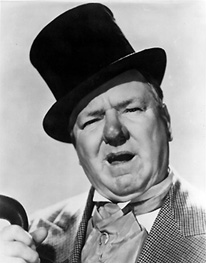Superman on Television
De-Constructing a Tabloid Caricature (Part 1 of 3)
[Date: January 2009]
 Musician, writer and biographer Jan Alan Henderson discusses the life and death of George Reeves, Superman of the 1950s.
Musician, writer and biographer Jan Alan Henderson discusses the life and death of George Reeves, Superman of the 1950s.
For many people, the face of Superman is that of actor George Reeves.
Reeves portrayed the Man of Steel for six seasons on "The Adventures of Superman," which aired from the Fall of 1952 to the Spring of 1958. However, on June 16, 1959, Reeves was found dead upstairs in his bedroom in his Hollywood home.
According to the June 17, 1959 issue of The New York Times:
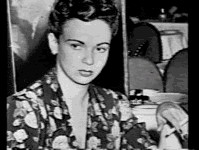
- "George Reeves, television's Superman, killed himself early today. Seconds earlier his fiancée [Lenore Lemmon, 35 at the time] had predicted his death.
"Friends said Mr. Reeves, 45 years old, had been depressed he could find no other acting jobs."
Later in the article, the reporter said that at 2:30 a.m., "Mr. Reeves was found dead on his bed, a bullet from a .30-caliber Luger pistol in his temple. No note was found."
And today people still discuss the unknown circumstances behind Reeves's death. It is probably because, as the Times reporter said, the Superman series brought Reeves "the devotion of a vast audience of children. But friends said this had given him no fulfillment as an actor."
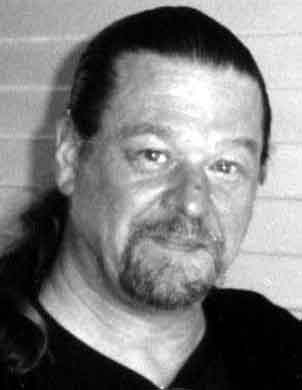 California based writer and musician Jan Alan Henderson has explored Reeves's life and death since the 1970s and has written two books on the subject Speeding Bullet and Behind the Crimson Cape. Henderson has also spoken about Reeves on the E! Entertainment Channel, A&E and on the DVDs of seasons two through six of "The Adventures of Superman."
California based writer and musician Jan Alan Henderson has explored Reeves's life and death since the 1970s and has written two books on the subject Speeding Bullet and Behind the Crimson Cape. Henderson has also spoken about Reeves on the E! Entertainment Channel, A&E and on the DVDs of seasons two through six of "The Adventures of Superman."
[Jan Alan Henderson Photo Courtesy of Steve Randisi]
Henderson took a great deal of time to discuss with the Superman Homepage, Reeves's life and death.
And, please note, the Superman Homepage owes a big "Thank You" to internet radio host Jeremiah Greer, of Shadows in the Dark Radio for his assistance regarding this interview.
A second "Thank You" goes to Carl Glass, of Glass House Presents for helping us get in contact with Mr. Henderson.
Glass House Presents has a fine collection of Hollywood memorabilia that is worth checking out.
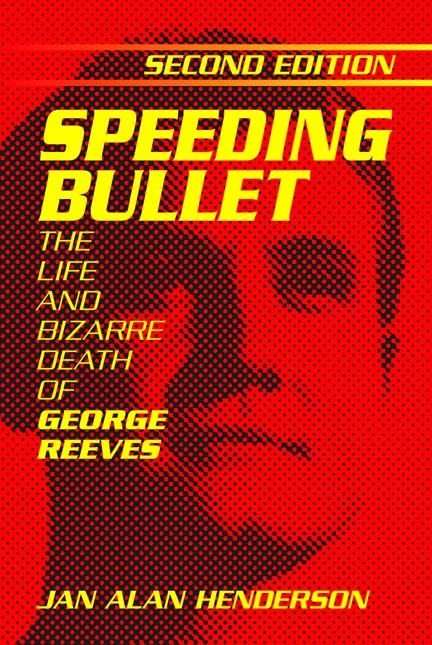 A third thank you goes to James Nolt, who operates a tribute site dedicated to George Reeves. It is with his permission, he is allowing us to use several pictures for this story.
A third thank you goes to James Nolt, who operates a tribute site dedicated to George Reeves. It is with his permission, he is allowing us to use several pictures for this story.
And another huge "Thank You" goes to Mr. Henderson for his assistance. He easily spent several days of his own time not only in helping this interview be prepared, being interviewed, but also spent several days helping us with follow up questions, answers and fact checking.
WRITING THE BOOK
Q: The subject of George Reeves seems like it is pretty daunting, considering his career, the mystique of Superman and add to this the unusual circumstances of his death.
JAN ALAN HENDERSON: I had people ask me, "How did you become obsessed with George Reeves?"
The fact of the matter is, I have never been obsessed with George Reeves.
If you want to look at how things fell into place in an organic fashion - I would find out things while working on other non-related George Reeves projects, I would say the subject matter became obsessed with me [LAUGHS].
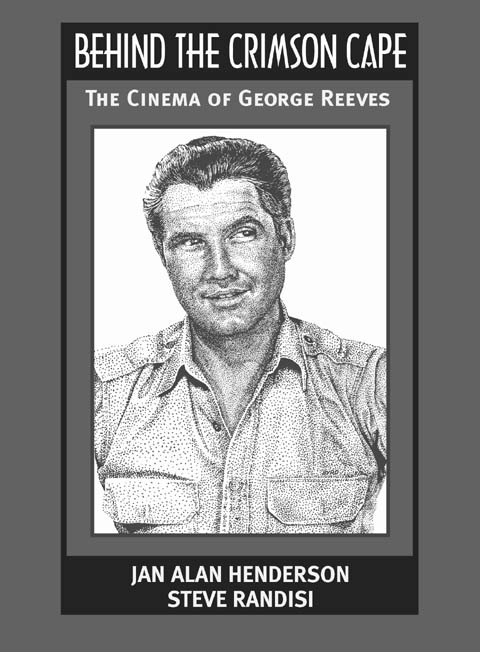 Q: If I can I can steer the conversation towards George Reeves, do you remember hearing about George Reeves's death when you were a child?
Q: If I can I can steer the conversation towards George Reeves, do you remember hearing about George Reeves's death when you were a child?
JAH: Yeah, I came out to breakfast on the morning of June 16th and it was on the front page of the newspaper.
I remember as I read this I asked, "How can Superman do this?"
After I read the entire article, my mother said to me, "Don't believe everything you read."
I asked, "What do you mean by that?"
And my mother said, "I think there is an awful lot more going on there...a bit more than meets the eye."
Q: Well let's take this back further, how did you get into "The Adventures of Superman?"
JAH: My introduction into Superman was thanks to a nanny I had who used to stick in front of the television on Thursday nights at 7:30 p.m.
We had a nanny because my mother worked late for the Hollywood Permanent Charity which was a nursing home for old actors. I got to know actor Edward Arnold and my mother was friends with Cecil Elliot in the early 1940s. Cecil was primarily a stage actress, who toured all over the country during World War II. She lived in Hollywood, and worked in television in the early 50s. Edward and Cecil were my godparents.
Cecil was the old lady, Elsa, in the wheel chair in the episode "The Evil Three" which aired during the first season.
Cecil had been an actress since the 1930s and appeared in a Stanley Kubrick film and acted in two Don Knotts movies - "The Love Doctor" and "The Reluctant Astronaut." She was also in "The Three Stooges Meet Hercules."
| AN AFTERNOON WITH CECIL ELLIOTT Q: Your friend Cecil Elliott sounds like a pretty amazing lady. JAH: One time in the 1930s she had been invited to the home of actor W.C. Fields, who died in 1946. She and some lady friends went to visit his home near Los Angeles. She was sitting there with her friends and Fields brought out a tray of drinks or the drink cart or whatever and Cecil was the only who partook. Q: Oh wow. JAH: Yeah Cecil could hold her own and she could handle her drink and Fields threw out the rest of her friends. Cecil stayed there with W.C. Fields and the two of them drank the afternoon away.
|
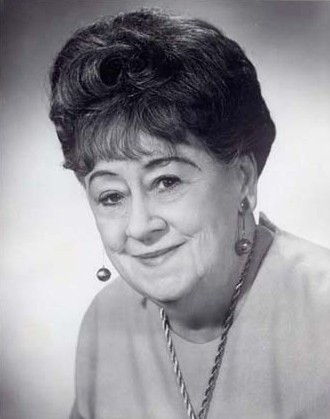 I grew up around her. Cecil had a fan from New York City named Mike Shields and he used to call her long distance; he was totally in love with the first season of "The Adventures of Superman."
I grew up around her. Cecil had a fan from New York City named Mike Shields and he used to call her long distance; he was totally in love with the first season of "The Adventures of Superman."Around 1978, Shields called Cecil. I guess I was at her house - I would drive her to auditions and act as her eyes and ears because she was getting on in age. I ended up talking to Mike Shields and he happened to have gotten the phone number for Lee Sholem.
Sholem had directed "Superman and the Mole Men" which was the first movie with George Reeves as Superman. Sholem had also directed several episodes of the "Adventures of Superman" series.
Shields told me Sholem's name was in the phone book and so I pulled out the phone book, and lo and behold, there was Lee Sholem's number.
I figured I would try to call because the worst he can do is hang up on me - which is no big deal. Or the worst he could say was "Take a walk, kid!" or "Get the hell out of here!"
[Cecil Elliot Photo Courtesy of Jim Nolt]
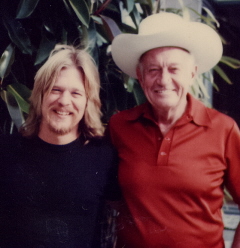 At the same time, I had been doing some business with a company called Nostalgia Merchants and they had a newsletter. So I figured I could pitch a Lee Sholem interview for that. I got the okay from the editor of the newsletter and I called Sholem.
At the same time, I had been doing some business with a company called Nostalgia Merchants and they had a newsletter. So I figured I could pitch a Lee Sholem interview for that. I got the okay from the editor of the newsletter and I called Sholem.
To my great surprise, Sholem invited my wife and me to his home to be interviewed.
[Jan Henderson & Lee Sholem circa 1978. Photo Courtesy of Jan Alan Henderson]
Unfortunately, the Nostalgia newsletter only lasted two issues and my interview with Lee Sholem was slated to go into the third issue. So the tape of the interview sat on the shelf until 1986 when Film Fax came out.
It was edited and published by Michael Stein in Illinois. Film Fax is still going strong, and is one of the best genre magazines on the market. I offered Mike the tape of the Lee Sholem interview.
To be honest, I had no interest in writing the article, I was willing to send him the tape of the interview because I told Mike Stein that an article on Sholem would be cool for his magazine. Not only had Sholem done the Superman shows, but he directed episodes of television shows like "Whirlybirds," "Lawman," "Long John Silver," "Sugarfoot," "Cheyenne," and "Bronco" and he also directed movies like "Pharaoh's Curse" and "Tobor the Great."
I ended up becoming a writer when shortly after I pitched the Lee Sholem idea, I got a call from Mike Stein. He wanted me to do an interview with Paul Marco, who had been in several Ed Wood movies because Stein was going to do an issue of Film Fax dedicated to Ed Wood.
I ended up at a restaurant with Paul Marco and I interviewed him for two hours. To be honest, that was an experience that would take a five hour interview to discuss!
Then all of a sudden I was a writer and I spent most of the time wondering "What the hell do I do now?"
Let's just say some of my early writing smelled, shall I say, like a non -well preserved deceased skunk [LAUGHS].
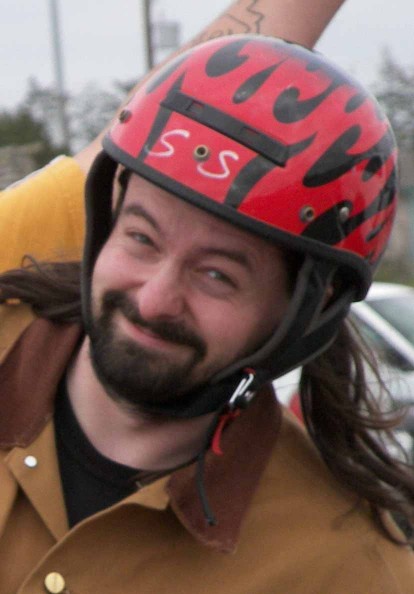 Q: You know that "What the hell do I do now?" is the battle cry of every writer I know! [LAUGHS].
Q: You know that "What the hell do I do now?" is the battle cry of every writer I know! [LAUGHS].
[WRITER'S NOTE: It is known for a fact, that this phrase is the life motto of Superman Homepage writer and reviewer Neal Bailey.
[Neal Bailey Photo Courtesy of Neal Bailey Industries, Ltd.]
Q: Now how did you go from this to your first George Reeves book, Speeding Bullet?
JAH: About 1993 or 1994, some writer had written a book on the Superman subject and to be honest it hadn't done very well. I happened to be at a movie screening with Mike Copner and Buddy Barnett, the publisher and editor of Cult Movies Magazine. And the two of them said, "We wish we had something about George Reeves!"
It was one of those things where my mouth went faster then my brain - and I said, "Give me six months and I will try and show you something."
Afterwards, I thought again "What the hell do I do now?" Other than the Lee Sholem interview, I had nothing to show.
So I started kicking around some ideas and I even checked out the available sources on George Reeves and his death but they were all full of errors and misnomers.
One day I was talking to a friend of mine named John Norris, who is from New Orleans, and he asked me "Do you want to talk to Fred Crane?"
Crane was also from New Orleans.
And I said, "You bet!"
FRIENDS OF GEORGE
Q: For the readers who do not know him, can you briefly explain who Fred Crane was in relationship to George?
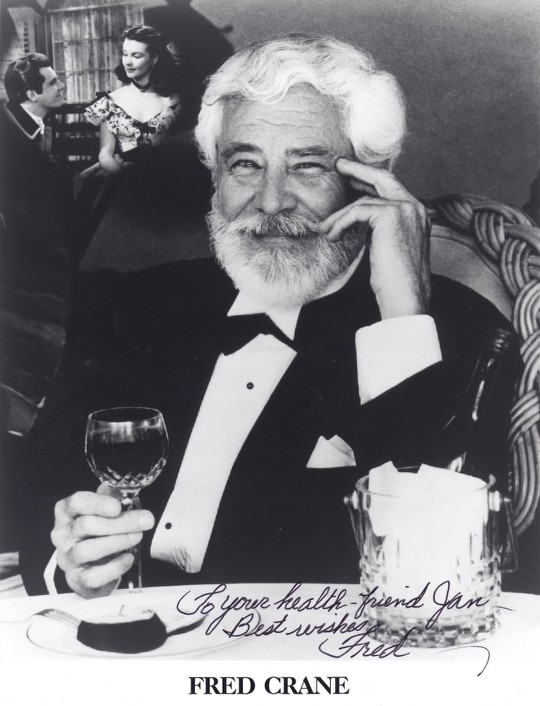 JAH: Fred Crane was an actor who basically did not start out to be an actor.
JAH: Fred Crane was an actor who basically did not start out to be an actor.
His mother had "stage mother aspirations"and sent him out to Hollywood and he won the role of one of the Tarleton twins in "Gone With the Wind."
George played the other twin.
All of a sudden, here he and George Reeves were having their hair dyed red, and the two of them sat down and became fast friends. And if I may add, that is what happened with me and Fred.
Like Sholem, Fred invited me over to his house and I am sitting there blown away that I have gotten away with this.
And we remained friends until he passed away in August of 2008.
[Fred Crane Photo Courtesy of Jan Alan Henderson]
Q: I am sorry to hear that.
JAH: We all were.
He had a long career. In fact, he was in a couple of episodes of the television shows "Lost in Space," the "Lawman" and he was the voice of classical music here in Los Angeles. I used to listen to him to all the time.
Q: No kidding.
JAH: Yeah, he was a deejay and that was the way he found out about George Reeves's passing.
He found out over a teletype when he was working at a radio station and I think he had to read it as the news.
Q: Oh gosh! It must've been difficult for him.
JAH: Well, yeah and the other thing was they were great friends during the filming of "Gone with the Wind" and after "Gone With the Wind."
Fred used to go down to George's stepfather's house with George in Manhattan Beach and hang out and have wine and food with them. George, and his stepfather Frank Bessolo, used to cook and loved to prepare these big meals.
But the bottom line was he had seen George on and off over the years and knew him during "Superman" so it was very devastating to him. Fred was one of the guys that ran into George just before he passed away.
They met at the intersection of Sunset Boulevard and Fairfax Avenue and George told Fred,
"Well I am getting into directing now. I am getting out from in front of the camera and I am getting behind the camera."
Q: So it sounds like once you met Fred Crane, other things fell into place for the book.
JAH: Yeah. We were able to find other people, like Anthony Caruso (who guest starred in "Czar of the Underworld"), an actor who has been in so many great things like "RKO Features" and a bunch of episodes of "Bonanza" and things of that nature.
Little by little all of these interviews started falling into place. I also met Harry Thomas, the make up artist for the first season of "The Adventures of Superman." Thomas also did the make up for several films of Ed Wood.
With this information I was able to put it together and turn in the manuscript for Cult Movies.
However, at this time I saw in the Star Magazine that Sam Kashner and Nancy Schoenberger were writing a book called the "Death of Superman" and it would later be called Hollywood Kryptonite.
So I went to Mike Copner and said, "If we get this thing out first, we can have the drop on it as being the first George Reeves biography! It will be a scoop for Cult Movies."
So we put it out and it came out in May of 1995 as the 14th issue of Cult Movies. We sold oodles of them.
It was so successful that I did "Mysteries and Scandals" on the E! Channel and there was such a demand for Speeding Bullet that it went through of a couple of other publishers who wanted to do a reprint abridged version. Those didn't pan out.
So I talked to my good friend Michael Bifulco at Bifulco Books, and we did another version of it in 1999.
It was updated and we added people like Walter Reed and quite a few other people.
Q: Who is Walter Reed?
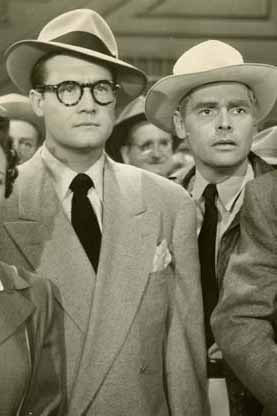 JAH: Walter Reed played Corrigan in "Superman and the Mole-Men." He guest starred in "77 Sunset Strip" and he did a serial for Republic Pictures called "Government Agents vs. the Phantom Legion," among loads of other things.
JAH: Walter Reed played Corrigan in "Superman and the Mole-Men." He guest starred in "77 Sunset Strip" and he did a serial for Republic Pictures called "Government Agents vs. the Phantom Legion," among loads of other things.
[Photo Caption: George Reeves and Walter Reed in "Superman and the Mole Men". Photo Courtesy of Jim Nolt]
He was also in a 1957 episode called "Atomic Captive." He and George were great friends and he remained great friends with George through out his entire life.
He was a working character actor when he met George when they did the play called Winged Victory. The play was in the mid-1940s and toured around the country.
It was kind of a propaganda boost, for World War II.
Q: Ever been to Metropolis, Illinois?
JAH: Yeah, in 2000 we attended the "Superman Festival." I went there with my friends Steve Randisi and Mike Bifulco.
We decided to do a follow up book called Behind the Crimson Cape which details George's film career outside of Superman. Once again this was published by Bifulco Books. It was Steve Randisi's idea to do Crimson Cape.
There was still more interest in Speeding Bullet so we did another edition of the book in 2006.
This second edition included an interview with Gene LeBell. He was George's friend and personal trainer at the time. In fact the two of them had a wrestling act.
Gene was a professional wrestler, stunt man, and stunt coordinator - and still is. They got a show together in the fall of 1957 and toured around the country - mostly in the western States - and I believe it might have made it to North Carolina.
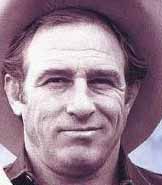 George was dressed as Superman and wrestled Gene. Gene's character was Mr. Kryptonite.
George was dressed as Superman and wrestled Gene. Gene's character was Mr. Kryptonite.
They were great friends, and Gene was there the morning before George died, training George.
Upon hearing of George's demise, he went to the house and the police unceremoniously threw him out.
They said to him, "If you know what is good for you, you will get the hell out of here before we arrest you!"
He is the one who said he saw, in George's bedroom where George was found dead, the throw rug had been moved and there were five bullet holes in the floor, under the throw rug. He tripped over the rug and discovered the bullet holes.
He has never believed George Reeve has killed himself and with good reason.
Q: Speaking of wrestling, wasn't George wrestling at a party before his death?
JAH: That was a Dr. Paul Hanson who wrestled George the Saturday night before he died, and it was not like they had a wrestling match that you saw with Gene LeBell as Mr. Kryptonite.
Dr. Paul Hanson was at a dinner party with George and Lenore Lemmon. Dr. Hanson had been an emergency room surgeon at Huntington Memorial Hospital and Pasadena Memorial Hospital. There were a bunch of kids there, and the kids wanted to see a wrestling match, and Dr. Hanson and George threw each other around the living room. Nobody was injured, and it was all in fun.
Well, I had I met Dr. Paul through his son who wrote to Cult Movies Magazine. He was one of the kids at the dinner party. We were pretty much ready to go to press with Speeding Bullet in 1995.
It was Dr. Paul's son who pleaded with me to speak to his dad. I said to him, "We pretty much have the manuscript completed, and I don't know if I can make the insert."
Q: It sounds like Dr. Paul gave you some valuable information. Were you able to get it in?
JAH: Yeah. I had to re-write in two weeks working 14 to 18 hour days
Q: Oh no! [LAUGHS]
JAH: I remember one evening my wife put some food in the room where I worked and I woke up one morning with my face in a plate of spaghetti. [LAUGHS]
That was pretty hilarious.
And let me say, it didn't taste like a gourmet meal the morning after.
Q: [LAUGHS] Right.
However, you said you essentially wrote Speeding Bullet to give a voice to George's friends right?
JAH: That was my intention.
My other goal was to try to present the material I had gathered over the years. You see, I tried to present his story looking into this as an amateur sleuth. I had been quietly researching George for twenty-six years, before putting the Cult Movies version out..
If George Reeves had committed suicide and been a horrible person, I think I would have found that out and I would have printed that. What I found out is, no one knows for sure what happened that night.
Like I said, I wanted to tell the stories of George's friends. I would meet somebody or talk to somebody that knew somebody and they would put me on the trail of someone else and I would try and get more information.
All this developed organically and by itself and I never thought, "If I can get an interview with 'this guy,' I can have a bang up end to such-and-such the chapter." There wasn't time for that.
So the bottom line is, I talked to all of these people - as many of them as I could who were alive and would speak to me.
Q: Was there anyone who did not want to talk about George?
JAH: There were a couple who did not want to speak with me who worked with George in the serials George was in, "The Adventures of Sir Galahad" (Columbia 1949), and I respected their wishes.
I really didn't want to talk to anyone who didn't want to talk to me because I did not think that was ethical and I did not think that was prudent either.
Q: Do any persons you interviewed stand out for you?
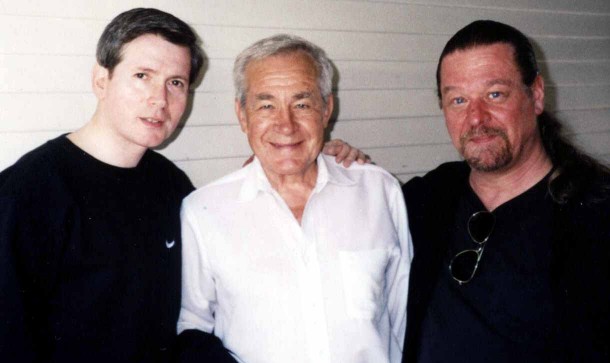 JAH: I would have to say Fred Crane, Harry Thomas - the make up artist was great. Phyllis Coates was great. And both Noel Neill and Jack Larson were great. Gene LeBell was dynamite!
JAH: I would have to say Fred Crane, Harry Thomas - the make up artist was great. Phyllis Coates was great. And both Noel Neill and Jack Larson were great. Gene LeBell was dynamite!
[Photo Caption: Writer Steve Randisi, Jack Larson and Jan Alan Henderson. Photo Courtesy of Jan Alan Henderson]
To be honest, they were all nice people, and very generous with their time.
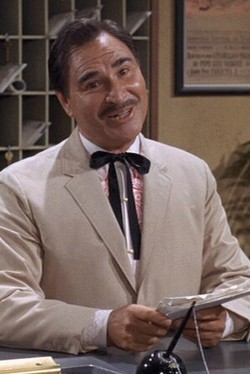 Actor Natividad Vacio, George's boyhood friend, was a little hesitant. However, he changed his tune with me on the phone in about five minutes.
Actor Natividad Vacio, George's boyhood friend, was a little hesitant. However, he changed his tune with me on the phone in about five minutes.
I have a great story about him.
When I put out the Cult Movies edition of Speeding Bullet before he died in 1999, I was recording at a recording studio that was so close to Vacio's house that it was separated by an alleyway.
I had given him some copies of the magazine and he was very impressed and he was very happy to see George's story being told the way he remembered it. He called me up again and thanked me, and asked me to deliver more books. I said, "Sure!"
Like I said, his door step was 10 feet away from the back step of the recording studio and when I was finishing up an all night session, I put a bunch of books on his doorstep.
He called and thanked me and he said, "Mr. Henderson you get up earlier than the paper man!"
He was he was understandably protective of George because there were so much tabloid garbage and trashy crap that had been written about George.
==
This interview is Copyright © 2009 Steven Younis. It is not to be reproduced in part or as a whole without the express permission of the Superman Homepage.

